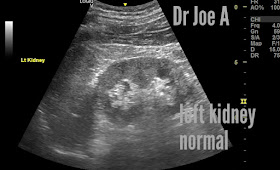Final diagnosis: cirrhosis with nodular fibrosis of liver with ascites with recurrence of carcinoma bladder with prostatomegaly.
Thursday, March 30, 2023
Interesting case of multiple pathologies
Final diagnosis: cirrhosis with nodular fibrosis of liver with ascites with recurrence of carcinoma bladder with prostatomegaly.
Tuesday, March 28, 2023
A rare cyst in a rare location in a 20 year old female
Friday, March 24, 2023
A swollen tender, painful thyroid left lobe
What is this odd sounding disorder?
De Quervain's thyroiditis is a self-limiting inflammatory condition of the thyroid gland that affects the left lobe in some cases.
It is also called subacute thyroiditis.
The condition usually presents with symptoms of pain, tenderness, and swelling in the affected area.
Ultrasound and color Doppler findings in de Quervain's thyroiditis affecting the left lobe of the thyroid in this case include:
- Hypoechoic (dark) areas within the thyroid gland
- Swollen left lobe thyroid
- Increased blood flow within the thyroid gland on color Doppler imaging
- Thickened capsule of the affected lobe
- Enlarged lymph nodes in the surrounding area
Management of de Quervain's thyroiditis: typically involves the use of non-steroidal anti-inflammatory drugs (NSAIDs) to control pain and inflammation. In some cases, steroids may be necessary to reduce inflammation and swelling. The condition usually resolves on its own within a few months, and long-term prognosis is excellent.
In summary, de Quervain's thyroiditis is also called subacute thyroiditis and here is affecting the left lobe of the thyroid, in this case can be identified on ultrasound and color Doppler imaging, with characteristic findings including hypoechoic areas, increased blood flow, and thickened capsule. Treatment involves NSAIDs and steroids, and prognosis is typically good with complete resolution of symptoms.
For more visit:
Wednesday, March 22, 2023
This calculus is huge, is it a staghorn?
Staghorn calculus is a large branching kidney stone that can partially or completely fill the pelvicalyceal complex (CHLC) of the kidney.



















































